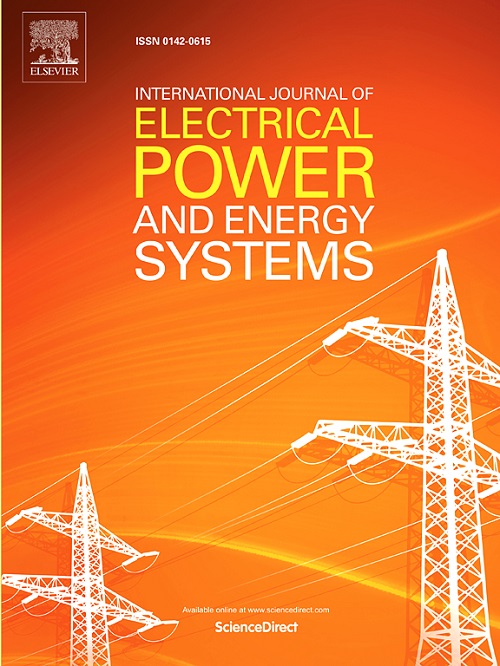Evaluation of electric vehicle consumption models based on real-world driving data
IF 5
2区 工程技术
Q1 ENGINEERING, ELECTRICAL & ELECTRONIC
International Journal of Electrical Power & Energy Systems
Pub Date : 2025-09-26
DOI:10.1016/j.ijepes.2025.111116
引用次数: 0
Abstract
As the adoption of Electric Vehicles (EVs) accelerates, understanding and accurately predicting EV energy consumption is essential for optimizing EV range, refining charging infrastructure, and improving overall efficiency. With advances in real-world data collection, this study evaluates seven distinct EV consumption models using driving data from a BMW i3 (60 Ah). The models were assessed based on assumptions, computational methods, and their ability to incorporate factors such as EV dynamics and environmental conditions. Performance metrics, including Mean Absolute Error (MAE), Root Mean Squared Error (RMSE), Symmetric Mean Absolute Percentage Error (SMAPE), and R-squared (R) were employed to compare model accuracy. The model incorporating detailed resistance forces and constant efficiency factors emerged as the most accurate across all metrics, demonstrating superior performance in predicting energy consumption. Conversely, a model incorporating key resistive forces and efficiency parameters while considering a minimum velocity threshold for power consumption showed the highest error rates. Furthermore, integrating machine learning techniques with physical models proved beneficial, enhancing predictive accuracy with the lowest SMAPE and capturing complex patterns in the data, achieving a balance between accuracy and interpretability. This research offers actionable insights into optimizing EV range, designing charging infrastructure, and improving energy efficiency modeling, providing a valuable reference for stakeholders in electric mobility and energy management. A key strength of this study is its systematic comparison of seven energy consumption models, using real-world driving data from a BMW i3 (60 Ah) to establish a new benchmark for EV energy modeling.
基于真实驾驶数据的电动汽车消费模型评价
随着电动汽车的加速普及,了解和准确预测电动汽车的能耗对于优化电动汽车续航里程、完善充电基础设施和提高整体效率至关重要。随着现实世界数据收集的进步,本研究使用宝马i3 (60 Ah)的驾驶数据评估了七种不同的电动汽车消费模式。这些模型基于假设、计算方法以及纳入电动汽车动力学和环境条件等因素的能力进行评估。采用平均绝对误差(MAE)、均方根误差(RMSE)、对称平均绝对百分比误差(SMAPE)和r平方(R2)等性能指标来比较模型的准确性。该模型结合了详细的阻力和恒定的效率因素,是所有指标中最准确的,在预测能源消耗方面表现出卓越的性能。相反,在考虑功耗最小速度阈值的同时,结合关键阻力和效率参数的模型显示出最高的错误率。此外,将机器学习技术与物理模型相结合被证明是有益的,可以以最低的SMAPE提高预测准确性,并捕获数据中的复杂模式,实现准确性和可解释性之间的平衡。该研究为优化电动汽车续航里程、设计充电基础设施和改进能效模型提供了可操作的见解,为电动汽车出行和能源管理的利益相关者提供了有价值的参考。这项研究的一个关键优势是它系统地比较了7种能耗模型,使用宝马i3 (60 Ah)的真实驾驶数据来建立电动汽车能源模型的新基准。
本文章由计算机程序翻译,如有差异,请以英文原文为准。
求助全文
约1分钟内获得全文
求助全文
来源期刊
CiteScore
12.10
自引率
17.30%
发文量
1022
审稿时长
51 days
期刊介绍:
The journal covers theoretical developments in electrical power and energy systems and their applications. The coverage embraces: generation and network planning; reliability; long and short term operation; expert systems; neural networks; object oriented systems; system control centres; database and information systems; stock and parameter estimation; system security and adequacy; network theory, modelling and computation; small and large system dynamics; dynamic model identification; on-line control including load and switching control; protection; distribution systems; energy economics; impact of non-conventional systems; and man-machine interfaces.
As well as original research papers, the journal publishes short contributions, book reviews and conference reports. All papers are peer-reviewed by at least two referees.

 求助内容:
求助内容: 应助结果提醒方式:
应助结果提醒方式:


